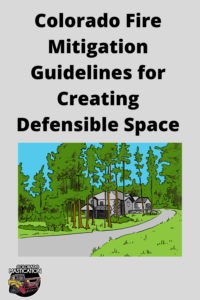Colorado Fire Mitigation Guidelines for Creating Defensible Space
Would like to know how much it costs to create defensible space around your Littleton home? Call today to schedule a free estimate on fire mitigation. (719)400-9104.
Colorado is one of the areas in the United States that suffers badly from wildfires. Fire mitigation is necessary to protect communities and the wildlife in the area. There are certain guidelines all areas should follow, including 
Defensible space is an excellent way to reduce the potential damage fires can cause. It helps to limit the spread of the fire, not stopping the fire altogether as fires are needed. The Colorado fire mitigation guidelines are in place for existing and new buildings.
The Creation of Defensible Space
Defensible space is an area around a building that is completely free of combustible fuels. This means the removal of debris and vegetation, treating the area to prevent the spread of fire.
The exact type of steps taken will depend on the area. Contractors will need to understand the topography of the area, the likely weather, and the local vegetation. This helps to create the right defensible space for effectiveness.
Basic Guidance for Fire Mitigation
The horizontal and vertical aspects of all vegetation in an area is assessed. Shrubs and trees are thinned, preventing the crowns from intersecting. With a gap, there’s less chance of the fire to jump.
Lower tree branches will need to be pruned and trimmed. This prevents fires from spreading upward to the canopies of trees.
The Creation of Three Zones
All buildings will have three zones, with Zone 1 as the closest to the building. As zones spread away from the fire, there is a lower risk to the buildings if fires occur, but these areas are essential to prevent the fires from even getting to Zone 1.
Zone 1: This is up to 30ft from the property. All combustible material is removed, including firewood stacks, fire-prone vegetation, patio furniture, and other items that are likely to catch fire and spread it to the home. Rock gardens, stone patios, and metal patio furniture are recommended for these areas. Before each fire season, all combustible litter needs to be removed from the roof and out of the gutter, while all trees are trimmed of overhanging branches.
Zone 2: Trees are fine in this zone, but they need to be will spaced out. The trees and shrubs are usually clumped together, creating islands of vegetation. These islands are surrounded by materials that don’t fuel the fire. Hardscape features such as gravel walkways and driveways are preferred around this area. Wood piles can be placed here, but they need to be further away from the boundary to Zone 1. All fuel tanks should also be stored far away from the Zone 1 boundary.
Zone 3: This is around 100ft from the property. The idea is to thin and prune the trees to prevent the spread into Zone 2. Fires may not be prevented, but they are slowed. This can help to take steps to put the fires out or give residents time to get out of their home to safety. You’ll find more vegetation in this area, which can help to improve the health of the wildlands.
To receive more information on creating defensible space in Littleton, feel free to contact us. Call us at (719)400-9104, or email at office@coloradomastication.com.
